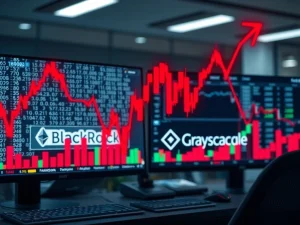Bitcoin Price: Navigating Crucial Consolidation Amid Volatility Risks

The cryptocurrency world is abuzz, and all eyes are fixed on the current state of the Bitcoin price. For over two weeks, the flagship cryptocurrency has been locked in a tight consolidation range, fluctuating between $115,000 and $120,000. This period of indecision has left many investors and traders wondering: what’s next? Is this a calm before a storm, or a strategic pause before an explosive move? This article delves into the forces at play, from significant institutional sales to macro liquidity trends, that are shaping Bitcoin’s immediate future and contributing to heightened crypto market volatility.
Understanding the Current Bitcoin Consolidation Phase
When we talk about Bitcoin consolidation, we’re referring to a period where the price trades within a relatively narrow range, indicating a balance between buying and selling pressure. For Bitcoin, this has meant holding steadfastly between the $115,000 support and $120,000 resistance levels. This sideways movement is often a sign of market uncertainty, where neither bulls nor bears have enough conviction to push the price decisively in one direction. Traders are meticulously watching these boundaries, as a significant breach could signal the next major price trend.
Several technical indicators are painting a complex picture:
- Bearish RSI Divergence: The Relative Strength Index (RSI) is a momentum oscillator. A bearish divergence occurs when the price makes a higher high, but the RSI makes a lower high. This often suggests that the upward momentum is weakening, hinting at potential downward pressure. For Bitcoin, this divergence has been noted, adding a layer of caution for some analysts.
- Rising Wedge Pattern: This is a bearish reversal pattern typically formed by two converging trend lines that are both sloping upwards. While it suggests a potential sharp breakout, the direction is often downwards, indicating that the asset might be losing steam after an uptrend. The identification of such a pattern in Bitcoin’s current chart suggests that while a breakout is imminent, its direction isn’t guaranteed to be positive.
- Dense Liquidation Clusters: According to Daan Crypto Trades, the $115,000 to $120,000 corridor is characterized by dense liquidation clusters. These are price points where a large number of leveraged trading positions would be automatically closed out if the price reaches them. A move beyond the current range could trigger a cascade of liquidations, significantly amplifying price swings and contributing to overall market instability.
This intricate web of technical signals highlights the delicate balance the market is currently experiencing. It’s a tug-of-war, and the outcome will likely have significant implications for short-term price action.
The Ripple Effect of Galaxy Digital Bitcoin Transactions
Adding another layer of complexity to Bitcoin’s current consolidation is the recent activity from institutional players, particularly Galaxy Digital Bitcoin transactions. The firm executed a substantial $1.5 billion BTC sale, alongside significant exchange transfers totaling 80,000 BTC. Such large-scale movements by major entities like Galaxy Digital inevitably send ripples through the market. While not always indicative of a clear directional bias, they introduce substantial liquidity and can heighten crypto market volatility.
Why do these transactions matter so much?
- Supply Dynamics: A large sale like Galaxy Digital’s injects a significant amount of Bitcoin into the market, potentially increasing supply and putting downward pressure on prices, at least temporarily. Conversely, large purchases can absorb supply and push prices higher.
- Market Sentiment: Institutional moves are closely watched. A major sale can be interpreted by some as a lack of confidence, while others might view it as strategic rebalancing. This creates mixed signals and contributes to the prevailing market uncertainty.
- Liquidity Impact: Large transfers to exchanges can increase the available supply for trading, potentially making the market more liquid but also more susceptible to rapid price changes if that supply is quickly bought or sold.
These large-scale transactions are a reminder that while Bitcoin is decentralized, the actions of large, centralized players can still exert considerable influence on its price dynamics and overall market sentiment.
Navigating Heightened Crypto Market Volatility Risks
The current market environment is ripe with risks, primarily due to the heightened potential for crypto market volatility. As Bitcoin hovers within its tight range, the stage is set for a significant move, which could be swift and impactful. The concept of liquidation clusters, as mentioned earlier, is central to understanding this risk. When prices breach these clusters, they can trigger a chain reaction, forcing leveraged positions to close, which in turn fuels further price movement.
Traders employing leverage are particularly exposed. A small move against their position can lead to significant losses, or even complete liquidation of their collateral. This creates a feedback loop: a price dip triggers liquidations, which puts more selling pressure, leading to further dips and more liquidations.
Beyond technical factors, broader market conditions also contribute to volatility:
- Macroeconomic Headwinds: Global economic data, interest rate decisions by central banks, and geopolitical events can all send shockwaves through traditional markets, which often spill over into the crypto space.
- Regulatory Uncertainty: Evolving regulatory landscapes in major economies can create apprehension among investors, leading to cautious trading or sudden sell-offs.
- Whale Activity: Similar to Galaxy Digital’s movements, other large holders (known as ‘whales’) can execute significant trades that single-handedly shift market dynamics, catching smaller traders off guard.
Monitoring these various facets is crucial for anyone navigating the current market. Understanding where stop-loss orders are clustered, for instance, can provide clues as to where sharp price moves might be initiated.
The M2 Liquidity Bitcoin Connection: A Macro Perspective
One fascinating aspect of the current market analysis points to a strong correlation between Bitcoin’s price movements and global M2 liquidity trends. As noted by Merlijn The Trader, the M2 liquidity Bitcoin relationship suggests that BTC has historically mirrored cycles of global money supply. M2 liquidity broadly refers to the total amount of money circulating in an economy, including cash, checking deposits, savings deposits, and money market mutual funds. When M2 liquidity expands, there’s more money available to flow into various assets, including cryptocurrencies.
Here’s why this connection is so vital:
- Capital Inflow: An increase in global M2 liquidity means more capital is seeking investment opportunities. A portion of this capital often finds its way into risk assets like Bitcoin, driving up demand and prices.
- Historical Precedent: Analysts observe that past Bitcoin bull runs have often coincided with periods of significant M2 liquidity expansion, particularly during quantitative easing measures by central banks. Conversely, periods of liquidity contraction have sometimes preceded or accompanied bear markets.
- Future Projections: If current liquidity flows remain strong, some analysts are projecting a potential rally for Bitcoin into the late summer, with targets ranging from $135,000 to $144,000. This macro perspective provides a potential long-term bullish counterpoint to the short-term technical uncertainties.
While technical analysis focuses on chart patterns and price action, understanding the macro liquidity environment offers a broader context for Bitcoin’s potential trajectory. It suggests that external economic forces play a significant role in determining the long-term viability of price surges.
What’s Next for Bitcoin Price? Key Levels and Scenarios
The immediate future of the Bitcoin price hinges on its ability to decisively break out of its current $115,000–$120,000 consolidation range. Market sentiment remains sharply divided, reflecting the high stakes involved.
Scenario 1: The Bullish Breakout
Some traders view the current consolidation as a “bullish pause,” a necessary re-accumulation phase before a significant move higher. A sustained breach above $120,000 would be a strong validation of this bullish momentum. Such a move could trigger a cascade of buy orders, potentially liquidating short positions and propelling Bitcoin towards the liquidity-driven targets of $135,000 and $144,000, aligning with the M2 liquidity projections. Traders would be looking for strong volume accompanying the breakout as confirmation.
Scenario 2: The Bearish Breakdown
Conversely, others caution about a possible drop if key support levels fail. A breakdown below $115,000 would reignite bearish concerns, potentially leading to a test of the $111,000 support level. This scenario could be triggered by negative macroeconomic news, further large institutional sales, or a general shift in market sentiment. A decisive break below $111,000 could indicate a deeper correction, potentially towards lower support zones.
Actionable Insights for Traders:
- Monitor Key Levels: Keep a close eye on $115,000 (support) and $120,000 (resistance). These are the battlegrounds.
- Watch Volume: A breakout or breakdown accompanied by high trading volume is generally more reliable than one on low volume.
- Observe Liquidation Sweeps: Pay attention to how the market reacts if prices briefly touch and then rebound from liquidation clusters, as these can signal market manipulation or liquidity grabs.
- Stay Informed: Keep abreast of global macroeconomic news and major institutional announcements, as these can quickly alter market dynamics.
The broader crypto market’s total capitalization, which reached an impressive $3.87 trillion in early July, reflects a rising bullish sentiment across the altcoin space. However, Bitcoin’s prolonged indecision within its range indicates that while the overall market is optimistic, investors remain cautious about BTC’s immediate direction.
Conclusion: A Pivotal Moment for Bitcoin
Bitcoin stands at a pivotal juncture. The ongoing consolidation within the $115,000-$120,000 range is a testament to the conflicting forces at play: institutional maneuvers from entities like Galaxy Digital, the ever-present threat of crypto market volatility driven by leveraged positions and liquidation clusters, and the overarching influence of global M2 liquidity Bitcoin trends. While the macro picture suggests potential for future rallies, the short-term Bitcoin price action remains uncertain.
For investors and traders, the coming days will be crucial. Whether Bitcoin confirms a bullish breakout towards new highs or succumbs to bearish pressure and tests lower support levels will largely depend on which side wins the battle for the $115,000-$120,000 corridor. Vigilance, informed decision-making, and a keen eye on both technical indicators and broader market narratives will be key to navigating this fascinating period in Bitcoin’s journey.
Frequently Asked Questions (FAQs)
Q1: What does “Bitcoin consolidation” mean, and why is it happening now?
Bitcoin consolidation refers to a period where its price trades within a narrow range, indicating a balance between buying and selling pressure. It’s happening now due to market uncertainty, significant institutional transactions like Galaxy Digital’s sales, and conflicting technical signals, leading to indecision among traders.
Q2: How do large institutional sales, like Galaxy Digital’s, impact Bitcoin’s price?
Large institutional sales, such as Galaxy Digital’s $1.5 billion BTC sale and 80,000 BTC transfers, inject significant supply into the market. While not always causing an immediate crash, they can increase market liquidity, contribute to price volatility, and influence market sentiment by signaling potential shifts in institutional confidence or strategy.
Q3: What are “liquidation clusters,” and how do they contribute to crypto market volatility?
Liquidation clusters are price points where a large number of leveraged trading positions are automatically closed out if the price reaches them. When prices move into these clusters, they can trigger a cascade of forced selling (or buying), which amplifies price swings and significantly increases crypto market volatility, especially for highly leveraged traders.
Q4: What is the significance of the correlation between Bitcoin and M2 liquidity?
The correlation between Bitcoin and M2 liquidity suggests that Bitcoin’s price often mirrors global money supply trends. An increase in M2 liquidity (more money circulating in the economy) can mean more capital available to flow into risk assets like Bitcoin, potentially driving up its price. This macro relationship provides a broader context for Bitcoin’s long-term price trajectory and potential rallies.
Q5: What are the key price levels to watch for Bitcoin’s next move?
The critical price levels to watch are $115,000 as a key support level and $120,000 as a significant resistance level. A sustained move above $120,000 could signal a bullish breakout, potentially targeting $135,000-$144,000. Conversely, a breakdown below $115,000 could lead to a test of the $111,000 support, indicating a potential deeper correction.










